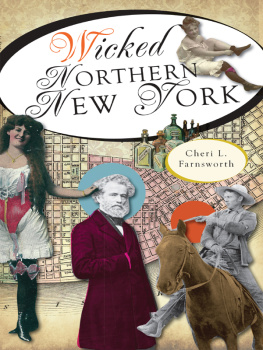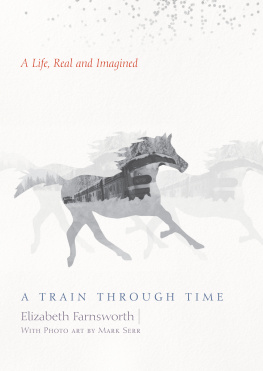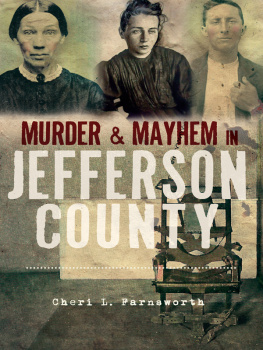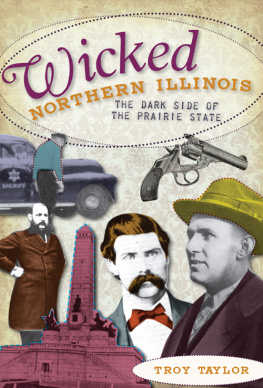

Published by The History Press
Charleston, SC 29403
www.historypress.net
Copyright 2011 by Cheri L. Farnsworth
All rights reserved
Cover images: Portrait of John Van Buren from the Brady-Handy Collection. Library of Congress Prints and Photographs Division; Man on horse photograph taken by Pinkertons National Detective Agency, circa 1900. Library of Congress Prints and Photographs Division.
First published 2011
e-book edition 2013
Manufactured in the United States
ISBN 978.1.62584.119.3
Library of Congress Cataloging-in-Publication Data
Farnsworth, Cheri, 1963
Wicked northern New York / Cheri L. Farnsworth.
p. cm.
Includes bibliographical references (p. ).
print edition ISBN 978-1-60949-305-9
1. Upstate New York (N.Y.)--History, Local--Anecdotes. 2. Upstate New York (N.Y.)--Biography--Anecdotes. 3. Rogues and vagabonds--New York State--Upstate New York--Anecdotes. I. Title.
F126.8.F37 2011
974.71--dc23
2011024493
Notice: The information in this book is true and complete to the best of our knowledge. It is offered without guarantee on the part of the author or The History Press. The author and The History Press disclaim all liability in connection with the use of this book.
All rights reserved. No part of this book may be reproduced or transmitted in any form whatsoever without prior written permission from the publisher except in the case of brief quotations embodied in critical articles and reviews.
For N and A
This ones for yougypsies, witches, hobos and all.
Eat, drink and be merry for tomorrow we shall die.
Imhotep (26552600 BC)

Photograph by Strohmeyer & Wyman, 1897. Library of Congress Prints and Photographs Division.
Contents
Preface
While I was able to locate several photographs of the actual individuals and places involved in the following stories, this book is mostly illustrated with images of unidentified people who best represent each chapter. I left no stone unturned trying to find more before coming to the conclusion that, had this book been exclusively about sensational murder cases or disasters occupying the pages of local papers for an extended period of time, there may have been images available. But Wicked Northern New York is, for the most part, a potpourri of lesser evils (horse thieves, body snatchers, gypsy swindlers, tramps, prostitutes, etc.). And because such stories were somewhat common in newspapers of the day, they rarely warranted the publishers added expense of illustrating them. Besides, it would have been difficult to try and pin down the transient beings, like gypsies, women of ill repute and wild men, who star in this crazy cast of characters long enough to do an engraving or even take a photographespecially when the guilty parties were often told to leave town on the next train in lieu of jail time.
Therefore, I carefully selected the following images from my own personal, fast-expanding collection of early photographs and postcards, as well as from the Library of Congress Prints and Photographs Division and the vault of images at Wiki Commons. Captions will indicate where each image came from. I hope you enjoy the stories and the pictures as much as I enjoyed compiling them for you.
Acknowledgements
Id like to thank my commissioning editor at The History Press, Whitney Tarella, and senior editor Jaime Muehl for their continued enthusiasm and expertise. And many thanks to the New England sales rep, Dani McGrath; Jamie-Brooke Barreto of sales and marketing; and my publicist, Katie Parry, and assistant publicist, Dan Watson. I always know Im in good hands with them.
Special thanks to Laura A. Foster, curator, Frederic Remington Art Museum, for helping me obtain the coveted image of Ameriga Vespucci. And thanks to Ann Werley Smallman, executive director of the Franklin County Historical and Museum Society; Margaret Gibbs, director, Essex County Historical Society/Adirondack History Center Museum; Kaleigh Ratliff, collections assistant at the Essex County Historical Society; Michele Tucker, librarian at the Adirondack Research Room in the Saranac Lake Free Library; and Amy Catania, executive director of Historic Saranac Lake for taking the time to search their files. Sincere gratitude also goes to the Northern New York Library Network for digitizing the regions newspaper archives in its Northern New York Historical Newspapers database and to the Library of Congress Prints and Photographs Division and Wiki Commons for doing the same with countless historic images.
I was blessed to come from a family of authors, songwriters, musicians and artists who not only gave me the genes and the drive to create but also provided me with the best support network anyone could ask for. For that, I thank my parents, Tom and Jean Dishaw, as well as my sisters, Cindy Barry and Chris Walker, and my brother, Tom Dishaw. And I can never possibly convey how grateful I am every single day for my daughtersMichelle, Jamie, Katie and Nikki. As the song goes, they fill my world with gladness
Most of all, I thank my wonderful husband, Leland Farnsworth II, who has always been tremendously understanding and supportive of what I do. He knows all too well what this calling of mine entails (with his own background in the literary field), and hes got my back.
Introduction
Wicked means a lot of things to a lot of people: evil, sinful and mischievous; severe, dangerous or foul. In slang, it can have positive connotations, denoting something that is really awesome (as in wicked cool). And, while I hope this book is wicked cool, the true stories chosen to best represent the title have to do with the sins of our ancestors, the vices and failings of human nature (greed, lust, apathy, ignorance, revenge, etc.) and the deeds borne of wickedness that inevitably breed lawlessness. In the early North Country, there was malice, like when a Potsdam man named Griffin was tricked into a pistol duel with a surprise ending in 1817 and when Mrs. Covey, an alleged adulteress from the town of Fine, was stripped naked, tarred and feathered by an angry mob as she stepped off a train with her mother and brothers in 1895. There were chilling abductions, like that of Mrs. Miller of Parishville, who was snatched from her bed in the early morning hours and dragged off into the night in a flimsy negligee in 1812. Her skull, with the chiffon gown wrapped around it, was found about four years later, tucked into a fissure in a cliff side several miles from her home. Freddie Brosseau was only six years old when he went missing from the Potsdam area in 1896. Incredibly, seventeen years later, he escaped from his abductors and found his way to a monastery near Montreal, where his family was summoned to confirm his identity; and a little girl in Clinton County was taken by gypsies around 1908, following the death of her mother and abandonment by her father. She was then sold to a proprietor of a house of ill repute for a paltry fifty cents, and he traded her to an abusive man for a half dozen chickens. The disappearance of a Stockholm man named Daniel Murdock was made even more bizarre by the fact that he appeared to have risen from the dead. It was reported that the young man tasked with tending to the corpse until the next mornings funeral fled the house only moments before the body went missing, when the familiar birthmark on the neck of the deceased reappeared, as if he were awakening.
Next page














